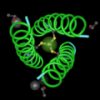Dave Robinson and Joann Lau from Bellarmine College in Kentucky are going to be describing their student project in a free webinar next Friday, May 16th. Their students clone GAPDH (Glyceraldehyde 3-Phosphate Dehydrogenase) genes from new plants, assemble the DNA sequences, and submit them to the NCBI. Here's an example.
Plus, since GAPDH is a highly conserved, it's a great model for looking at evolution.
You can get more information and register here.

The cool thing about plants is that there's lots of material to work with.
More like this
This the third part of case study where we see what happens when high school students clone and sequence genomic plant DNA. In this last part, we use the results from an automated comparison program to determine if the students cloned any genes at all and, if so, which genes were cloned.
What happens when high school students clone and sequence genomic DNA?
Shorter "Absence of xenotropic murine leukaemia virus-related virus in UK patients with chronic fatigue syndrome":
170 more CFS samples from two different cohorts.
395 more healthy controls.
I am so sick of this crap. BUT! A group in China made a really neat Real-Time PCR strategy for detecting XMRV, so Im still gonna write about it :)

What a fantastic idea!
Its easily extended to so many other areas of biology too - such as insects or fungi that can be easily found and has the potential to give students a real appreciation of how molecular genetics provides the best current proof of common descent.
The Circle Is Closed! When I was a grad student, a LONG time ago, as the exercise for a biochem lab class we purified and crystallized GAPDH. But we didn't solve the structure. :-) And there wasn't a PDB then anyway.
You know, this sounds like it would be an interesting sort of way to do a metagenome. A single set of DNA distributed amongst several collaborators at different schools, teaching several microbiology classes, with 96 well plates split amongst several lab students.